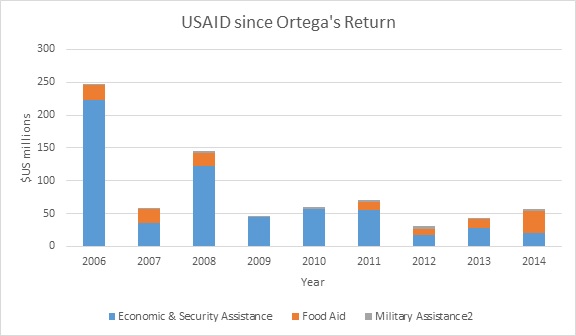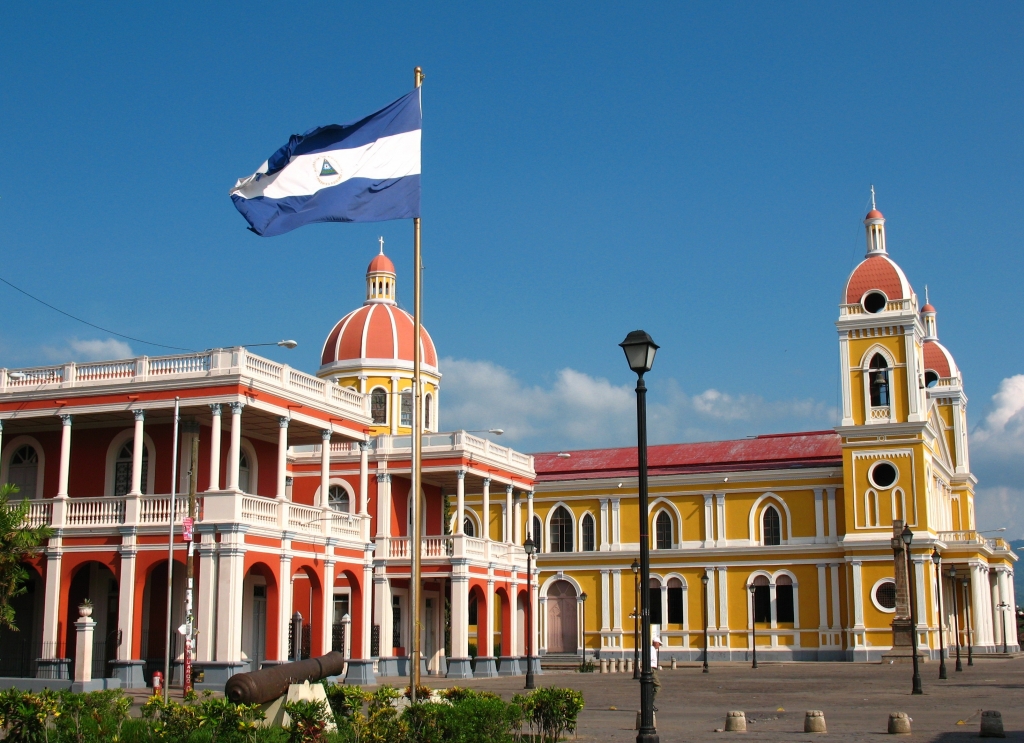As the second poorest country in the Western Hemisphere and with 42.5% of its population below the poverty line (Central Intelligence Agency), Nicaragua is in dire need of economic assistance. Yet in the past decade, US aid to the Central American country has greatly decreased. As shown in the graph below, in 2006 the US provided just under $250 million in aid, however by 2014 that amount dropped to $56.4 million (USAID), and according to the US Foreign Assistance website the planned spending for Nicaragua this year is even lower, a mere $18.15 million. So what occurred in the years after 2006 that could explain this persistent cut in US funding? An examination of Nicaragua’s political context during the past decade provides a clue to the puzzle. Daniel Ortega’s return to the presidency in 2007 and the US’s response to his administration have damaged relations between the two countries, directly resulting in a repeated reduction in US funding.

Ortega’s first reign of power was between 1979 and 1990 after the socialist Sandinista National Liberation Front overthrow of the Somoza dynasty, an oppressive dictatorship which had been in place in Nicaragua since 1936. Ortega first served six years as Coordinator of the Junta of National Reconstruction and then the remaining five years as President. During the 11 years of Sandinista rule, the US cut off aid to Nicaragua and instead supported the right-wing rebel group, the contras. Aid was not reinstated until 1990, when the Sandinistas peacefully ceded power to the democratically elected Violeta Chamorro, during whose leadership the neoliberal policies of the Washington Consensus were implemented. The two years of 1990 and 1991 saw the highest levels of economic aid to Nicaragua, reaching around $350 million (US Foreign Aid).
In 2007, Ortega returned to the presidency for his second non-consecutive five year term. Ortega has not been especially friendly toward the US since Ronald Reagan backed the contras during the 1980s, and his continued anti-US rhetoric (McPherson) suggests that position has not changed. The 2008 municipal elections following Ortega’s return to power brought reports of fraud, and the US responded by slashing aid, which dropped by $62 million between 2008 and 2009 (USAID). Additionally, in the 2011 presidential election, Ortega was reelected after the Supreme Court overturned the presidential reelection limits set by the Nicaraguan constitution. This act was very controversial because it could possibly allow Ortega, or any future leader for that matter, to be reelected indefinitely. Certain Nicaraguans even went so far as to compare Ortega’s path with that of the despised previous dictator, Somoza (BBC). The US reacted to Ortega’s sidestepping of the constitution by cutting aid again – between 2011 and 2012, the total aid dropped from 71.2 million to 31.1 million. After that cut, Ortega struck back at the US by declaring he would block all US funding to Nicaragua’s civil society (Rogers).
Another concern the US government has with the Nicaraguan president is his close ties to other leftist, anti-US nations in Latin America, such as Cuba, Venezuela and Bolivia. Cuba was Nicaragua’s chief ally during the US backed Contra War. Ortega was closely allied with Hugo Chavez, and Nicaragua still receives financial aid from Venezuela. In 2012, Venezuelan aid to Nicaragua was $728.7 million; however, with oil prices decline in recent years, Venezuela has had to significantly reduce its amount of foreign assistance (Stratfor). Furthermore, Nicaragua, along with Venezuela, Cuba, and Bolivia, is a member of ALBA (Bolivarian Alliance for the Peoples of Our America), which is a leftist alternative to the US sponsored FTAA (Free Trade Area of the Americas).
With this context in mind, the cutback of US aid can be clearly seen as a political move meant to discourage methods and actions the US considers undemocratic or anti-American. However, these actions are risky because they could potentially radicalize Ortega by pushing him further away from the US, while simultaneously hurting the Nicaraguan people who have very limited power over the situation. Ortega views the aid cut not as a gentle push to hand over the reins to another president but rather as an attack on his leadership and on his country. One must remember that the last time Ortega was in power, the US was funding his opponents during the Contra War, a bloody conflict that cost Nicaragua 50,000 lives (which make up 2% of its total population), as well as massive infrastructure damage (FSD International). His antipathy toward the US is no small wonder when one takes into consideration the US’s role in that terrible decade.
The tragedy of the situation is that the ones who inevitably suffer the most from this breakdown in US-Nicaraguan relations are the people of Nicaragua. What remains to be seen is whether the November elections this year will keep Ortega in power and if so, will the US and Ortega find an alternate path to diplomacy or continue down the road of animosity at the expense of the Nicaraguan people.
Sources:
“Central America and Caribbean: Nicaragua.” CIA World Factbook. Central Intelligence Agency, 01 Mar. 2016. Web. 30 Mar. 2016. Available at https://www.cia.gov/library/ publications/the-world-factbook/geos/nu.html
“Development Experience Clearinghouse.” USAID. Web. Available at https://dec.usaid.gov/dec/search/SearchResults.aspx?q=IlVTQUlEIGdyZWVuYm9vayBbZ3JlZW4gYm9va10i&ctID=ODVhZjk4NWQtM2YyMi00YjRmLTkxNjktZTcxMjM2NDBmY2Uy&svn=ODVhZjk4NWQtM2YyMi00YjRmLTkxNjktZTcxMjM2NDBmY2UyIXZpZXdJRF83MTk3Zjk4My04MmRlLTRhZWYtODBjNy1lMzIwNjBiYTVhMmY
McPherson, Alan. "The Return of Violent Anti-Americanism in Latin America." History News Network, 19 Oct. 2008. Web. 05 Apr. 2016.
“Nicaragua: Ortega Allowed to Run for Third Successive Term.” BBC News. N.p., 29 Jan. 2014. Web. 29 Mar. 2016. Available at http://www.bbc.com/news/world-latin-america-25937292
“Nicaragua: A Development Overview.” War Statistics. Foundation for Sustainable Development, n.d. Web. 29 Mar. 2016. Available at http://www.fsdinternational.org/country/nicaragua/devissues
Rogers, Tim. "Ortega in Old Form after U.S. Aid Cuts." The Tico Times. N.p., 29 June 2012. Web. 30 Mar. 2016. Available at http://www.ticotimes.net/2012/06/29/ortega-in-old-form-after-u-s-aid-cuts
Rogers, Tim. "US Cuts Aid to Its Poor Old Foe." GlobalPost. N.p., 21 June 2012. Web. 30 Mar. 2016. Available at http://www.globalpost.com/dispatch/news/regions/americas/ 120621/nicaragua-us-aid-ortega-chavez-clinton-sandinistas
“U.S. Overseas Loans and Grants to Nicaragua.” US Foreign Aid. Inside Gov, n.d. Web. Available at http://us-foreign-aid.insidegov.com/l/125/Nicaragua
“What Venezuela's Economic Decline Means for Nicaragua.” Strat for. N.p., 20 Aug. 2015. Web. 30 Mar. 2016. Available at https://www.stratfor.com/image/what-venezuelas-economic-decline-means-nicaragua








